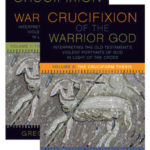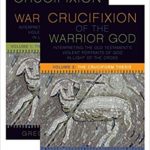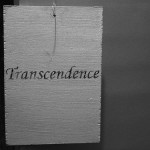We run our website the way we wished the whole internet worked: we provide high quality original content with no ads. We are funded solely by your direct support. Please consider supporting this project.

A Response to “Are Greg Boyd and I Reading the Same Old Testament?”
Collin Cornell has recently published a review of Cross Vision (CV) and, less directly, of Crucifixion of the Warrior God (CWG) in The Christian Century. In this post I will respond to the two major objections Cornell raises against these books.
Cornell begins by recounting a discussion I had with a woman who was deeply impacted by the cross-centered way of interpreting the Old Testament’s (OT) violent depictions of God. This dear lady compared her previous relationship with God to dating the “man of her dreams,” only to find out that he had massacred a classroom full of children at some point in the past. She told me that, regardless of how ideal this man seemed in the present, she could never fully give her heart to someone who had ever committed such an atrocity. So too, while this woman absolutely adored the God that is revealed in Christ, she told me that she had never been able to fully surrender her heart to him. For as beautiful as God is as he’s revealed in Christ, the OT taught her that God had in the past ordered the merciless massacre of thousands of innocent women, children and babies.
This woman experienced a dramatic and beautiful change once she embraced the cross-centered way of interpreting the OT’s violent depictions of God. As Cornell reports,
Tearfully she told [Boyd] that “today you helped me see that I don’t need to believe God ever ordered babies to be massacred! I can finally let myself believe God really is as beautiful as the cross reveals him to be! I can finally trust God with my entire heart!”
From this encounter Cornell surmises that my hope is that CV and CWG “[elicit] from its readers the same breakthrough of trust in God that the woman experienced.” He is absolutely correct about this, and I have been overwhelmed and humbled by the multitude of testimonies I’ve received from people who have had “breakthrough” experiences similar to this woman. Yet, while Cornell grants that “Boyd’s vision is spiritually earnest and his program commendably Christ-centered,” he nevertheless has serious reservations about my proposals.
First, Cornell spends a good portion of his review arguing that I convey an overly negative view of the OT. “Only very occasionally does Boyd claim that what is written in the Old Testament itself points faithfully to the character of God,” he states. As the title of his review indicates, Cornell believes he has a much more positive perspective on the OT than I. He testifies that he “found the God of the Old Testament stunning—beautiful and worthy of worship—and not just in the handful of passages that Boyd approves.” While he assumes that I view the OT as mostly “false and sub-Christian,” he finds “a vast, continental theological consonance” between the OT and “the God made known in Jesus Christ.”
Cornell doesn’t want “to shrug off the troubling theology or ethics of the Old Testament,” but he insists that “the Old Testament holds more (and much more) than just such troubles,” which, he claims, “is more than Boyd seems to grant.” And he continues:
When [Boyd] brings up Deuteronomy, it is only as a purveyor of genocide. Leviticus is a list of capital offenses. Numbers is a theological fossil preserving the archaic belief that God enjoys the smell of burnt offerings. These claims are not wholly wrong so much as drastically reductive.
In response, I won’t deny that I have a more critical perspective of the OT than Cornell. Cornell argues that while “the New Testament preaches Christ by name while the Old does not…. the Old knows God no less.” If Cornell is correct, I have no idea what to do with all the passages in the NT that contrast the superior revelation of God that we are given in Christ with aspects of the OT (e.g. Jn 1:17-18; Heb 1:1-3). I spend 14 pages in CV and 56 pages in CWG discussing this contrasting material.
However, while our views certainly differ, Cornell’s claim that I only “approve” of “a handful of passages” and that I see little more than “troubles” in the OT could not be more mistaken. In CWG, for example, I note that, while the focus of this book is exclusively on the problematic depictions of God in the OT, ”I do not want readers to get the impression that this is the primary way OT authors portray Yahweh.” And I continue,
…people who read Scripture sympathetically generally find that the God of the OT is by-and-large a relational God of hesed (i.e., covenant-love) who continually strives to bring all people…into relationships of shalom and covenantal righteousness/justice with himself as well as with each other (CWG, I, 281).
And after reviewing some of the beautiful depictions of God in the OT I conclude,
It is evident that the normative conception of God in the OT is perfectly consistent with the God who is decisively revealed in the crucified Christ. And this should never be forgotten when we turn to examine the “texts of terror” that comprises “the dark side” of the Bible (CWG, I, 286).
I trust it is evident that I am largely in agreement with Cornell in holding that the normative view of God in the OT is “stunning…beautiful and worthy of worship,” as he puts it. Yet, while I direct readers who are interested to 20 scholarly works that highlight this normative view of God in CWG, the focus of both of my books is strictly on the “troubling theology or ethics of the Old Testament.” It should therefore hardly be surprising that these works treat Deuteronomy more or less as “a purveyor of genocide” and Leviticus as a “list of capital offenses.” For Cornell to deduce from my highly selective treatment of the OT in these books that I only “approve” of “a handful of passages” is completely misguided and unwarranted.
Having said this, I must acknowledge an element of truth in Cornell’s critique. In the process of editing the 1,492-page CWG down to the 280-page CV, I removed most of my statements concerning the OT’s beautiful, Christ-like portraits of God. My reasoning was that lay readers would likely already be familiar with the positive depictions of God in the OT but mostly unaware of the most troubling depictions, since preachers rarely if ever address this material. Moreover, I assumed readers would understand that the focus of this work was exclusively on the problematic material of the OT and, therefore, that this work did not represent my over-all estimation of the OT. Given Cornell’s critique, however, it seems I may have assumed too much.
Cornell’s second major criticism of CV and CWG is that my “proposal is nothing if not an example of Sachkritik,” which he describes as a concept that “pivots on the notion that scripture is not wrong just in chronological detail or historical incident, but wrong theologically.” He argues that “Boyd’s regimen of Sachkritik systematically doubts the veracity of the Old Testament vis-à-vis the character of God.” Indeed, he contends that “Boyd has placed a large question mark—if not a strikethrough—over God’s promises to Israel,” and this “makes it nearly impossible to utter an ‘Amen’ to all God’s past promises that are “Yes” in Jesus Christ (2 Cor. 1:20).”
In response, I will first say that I don’t believe it’s accurate to claim that my “proposal is nothing if not an example of Sachkritik.” It’s true that the first step of my approach includes repudiating the surface content of portraits of God insofar as this content contradicts the definitive revelation of God in the crucified Christ. But the cross-centered approach I’m proposing requires this only as a means of looking through this surface content to discern God stooping to bear the sin of his people, just as we by faith look through the sin-mirroring surface of the cross to discern God stooping to bear the sin of the world. The goal of this approach, in other words, is not to repudiate Scriptures violent material, but to assess the positive revelatory content of this material and to thereby disclose how it bears witness to the cross, as I believe all Scripture must. This is why I am strongly critical of those who assume that the problems posed by the OT’s violent portraits of God are solved when they simply dismiss these portraits as inaccurate (CWG I, 335-378). And in this respect, the cross-centered approach that I propose differs radically from Sachkritik as traditionally practiced by historical-critical scholarship.
Second, I fail to see – and Cornell fails to explain — how my cross-centered approach to the OT’s violent portraits of God undermines our ability to trust that all God’s promises are “Yes” and “Amen” in Christ. In both CWG and CV I strongly emphasize the all-important truth that Jesus is the ultimate fulfillment of all God’s promises to Israel, which is precisely why I contend that we are trusting all these promises only when we are placing our total trust in Jesus Christ! The fact that I assess sub-Christ-like aspects of the OT to be divine accommodations that point us to the cross does not in any way undermine this. To the contrary, the cross-centered approach discloses how even the ugliest aspects of the OT find their fulfillment in the crucified Christ.
Third, Cornell’s objection to my repudiation of the surface meaning – or what he calls the “plain sense” – of violent portraits of God strikes me as a bit odd in as much as his own review indicates that he also is willing to repudiate the “plain sense” of these portraits. To illustrate, when discussing how he would respond to the woman who expressed her difficulty with violent depictions of God, Cornell says he would encourage her to look “through and beyond” the difficult “plain sense” of these depictions to discern “something enduringly true about God and life before God.” Does not this advice indicate that Cornell assumes that the “plain sense” of these violent depictions does not contain “something enduring true about God and life before God”? Why else encourage this woman to look through and beyond this surface meaning? And if Cornell accepts the “plain sense” of these violent portraits, what possible good would it do to encourage this lady to look through and beyond this “plain sense,” since her problem was precisely with the “plain sense” of these violent portraits?!
Not only does it seem that Cornell repudiates the “plain sense” of these portraits just as I do, but the manner in which he looks “through and beyond” this “plain sense” to discern the positive revelatory content of these portraits is strikingly similar to what I propose. The only difference is that, while Cornell encourages us to look through the surface of these violent portraits to discern enduring spiritual truths about God and life, I encourage us to look through their surface to discern God doing in past what he does in a definitive way on the cross: namely, stooping to bear the sin of his people, thereby taking on an appearance that mirrors the ugliness of that sin.
At the same time, while I contend that the primary revelatory content of violent divine portraits is discerned in the manner in which they anticipate Calvary, I completely agree with Cornell that there are other enduring spiritual principles that can be discerned in these portraits. Indeed, in CWG I spend eleven pages discussing how readers can discern such truths, and, interestingly enough, my recommendations are along the lines that Cornell proposes in his review ( I CWG II, 1087-98).
I am thus left wondering why Cornell thinks his approach contrasts with my own. Moreover, given the commonality of our perspectives, I am left wondering why Cornell would object to the cross-centered interpretation of Scripture’s sub-Christ-like material that I propose, which brings me to the aspect of Cornell’s review that I found most puzzling. While he briefly spells out my cross-centered approach and is generally accurate in doing so, he never offers his own assessment of it. Yes, he addresses what he thinks are the negative ramifications of this approach, as I discussed above, but he never offers a positive or negative critique of the approach itself. Given that this is the heart of both CV and CWG, and given that everything else in these books hangs on the validity of this approach, I frankly find this omission to be odd.
In sum, Cornell fails to assess the heart of both books, misjudges my over-all view of the OT, and criticizes me for employing a critical methodology that he himself employs. In my estimation, this considerably lessens the value of this review to potential readers of either of these two books.
Image credit: State Library of Queensland
Category: General
Tags: Book Reviews, Cross Vision, Crucifixion of the Warrior God, Cruciform Theology
Related Reading

5 Differences Between The Kingdom of God and the Kingdom of the World
Image by matthijs rouw via Flickr The kingdom of God looks and acts like Jesus Christ, like Calvary, like God’s eternal, triune love. It consists of people graciously embracing others and sacrificing themselves in service to others. It consists of people trusting and employing “power under” rather than “power over,” even when they, like Jesus, suffer because…

Crucifixion of the Warrior God Update
Did you know that authors generally don’t have much say-so about the cover art for their books? It’s considered part of the marketing, so the author may or may not like how it ends up looking. I’ve had a few book covers that made me scratch my head. (I won’t tell you which ones, but it would…

Reviewing the Reviews: Tom Belt (Part 2)
In my previous post I reviewed Tom’s critical review of volume 1 of CWG, and in this post I’d like to do the same for his critical review of volume 2. As he did in his review of volume I, Tom begins with some praises and points of agreement. He thinks my quest to discern “what…

The Centrality of Christ in Hebrews, Part 1
The intense Christocentricity that the New Testament writers embrace is nowhere more clearly and consistently illustrated than in the book of Hebrews. Throughout this work we find a repeated emphasis on the many ways the revelation given to us in Christ surpasses that of the Old Testament. The author begins by stressing how the revelation…

Crucifying Transcendence
The classical view of God’s transcendence in theology is in large borrowed from a major strand within Hellenistic philosophy. In sharp contrast to ancient Israelites, whose conception of God was entirely based on their experience of God acting dynamically and in self-revelatory ways in history, the concept of God at work in ancient Greek philosophy…

Part 1 (of 15): Introduction — What’s Up With Jordan Peterson?
Assessing Jordan Peterson’s “12 Rules for Life” by Greg Boyd Over the last two years I have, with increasing frequency, been asked what I thought of the views of this maverick Canadian thinker named Jordan Peterson. Sometimes the question was asked by admirers, if not devotees, of his writings and (more commonly) of his online…
